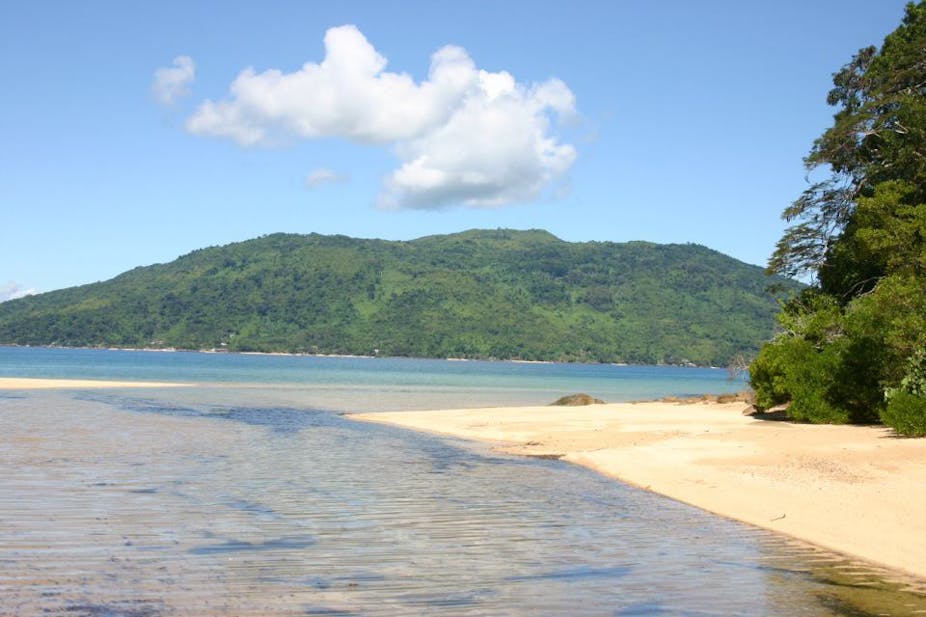The world’s coral reefs are both beautiful and rich in biodiversity, supporting a number of marine species. However the negative effects of climate change and human activity have begun to take their toll on these delicate ecosystems, with coral bleaching, damaged structures and the loss of species already occurring.
Though there are many issues threatening the health of coral reefs, for those that have grown near the shore, sedimentation is a major problem.
Deforestation can cause high amounts of soil erosion. With rainfall the loose soil finds its way into coastal waters through waterways. The muddy freshwater smothers the coral, blocking light and damaging coral tissue, which can lead to bleaching and deterioration of the reef and its ecosystem.
Our recently published study found that a hotter and drier climate will limit the flow of sediment into coastal waters, however these climate change-driven declines are outweighed by the impact of deforestation.
When it comes to dealing with this risk in the future, the best policies will be those that focus on the land, promoting better management and increased forest cover.
To Madagascar
Madagascar is a well-known biodiversity hotspot with its different regions representing a wide range of tropical climates. However the human population has struggled with preserving the island’s environmental integrity. Around 90% of the original forest cover has been lost in the 2000 years since human contact.
This has placed pressure on the conservation of the coral reefs that exist off the shores of Madagascar as they are damaged by the freshwater and sediment that flow from the river systems.
By modelling four river systems adjacent to Madagascar’s major coral reef systems we aimed to find an understanding of how best to protect these reefs.
The modelling involved computer simulations of sediment released near coral reef areas for the present day and 2090. These were carried out for different scenarios of projected temperature and rainfall, while also modelling the impact of reduced or increased forest cover.
On average, temperature is expected to increase while rainfall is expected to decline by 2090, with a tendency for wet season to become wetter and dry season to become dryer. These changes will lead to a decline in the flow of sediment into coastal coral reefs. Therefore, climate change alone will not accelerate reef sedimentation, as was previously thought.
Land use however, and in particular changes in forest cover, have significant impact on the amount of sediment discharged to coral reefs. Already sediment has increased five-fold since human settlement in Madagascar. This surge will continue if forests keep being cleared. Increasing forest cover in Madagascar through reforestation will reduce the amount of soil washing into coastal waters and further protect the reefs from the adverse effects of sedimentation.

The predicted drier climate may also have wider implications for the biodiversity of Madagascar beyond the protection of coral reefs. Future hydrological changes may have severe consequences for certain fauna and flora. This is especially so in the south west of the island where our simulations show the largest decrease in rainfall.
These changes may also set off a chain of socio-ecological problems. Many traditional pastoralists in the southwest have already swapped farming for fishing. This may lead to potential problems in managing marine resources, as their practises will differ from those of traditional fishers. As the climate becomes drier and less suitable to farming, these marine stocks will become increasingly important as food for the local population.
Beyond Madagascar
Most coral reef research in Australia has concentrated on the Great Barrier Reef (GBR), where many coastal reefs are affected by sediment flowing from rivers draining the Queensland hinterland. Land clearing for farming and agriculture has transformed the hinterland since Europeans first set foot in Australia. As a result river sediment discharge has increased at least 5 to 10-fold since the mid-1850s.
More recent surveys since the mid-1980s have revealed that coral growth and calcification (the amount of coral skeleton formed yearly) in inshore reefs along the vast Great Barrier Reef have suffered from the adverse impacts of sediment and nutrients from river runoff.
Projections for future Queensland rainfall are highly uncertain. More research is needed to get a better handle on future trends in rainfall and river runoff. Certainly modelling similar to what was used in Madagascar may be able to capture the most likely future climate of the GBR hinterland catchments and could be of great benefit for GBR management.
In the meantime, a likely effective management action is to further reduce pesticide and nutrient runoff from the hinterland to improve water quality in the GBR. This means, that it becomes increasingly important to engage with all stakeholders to develop targeted solutions to preserve our valuable coral reefs and buy time for coral reef ecosystems to cope with warming oceans, the most severe immediate threat from climate change.

